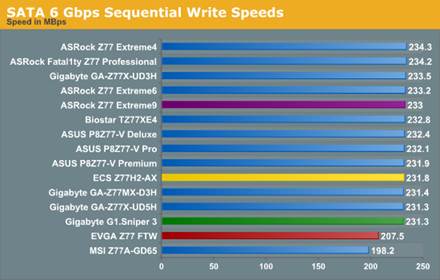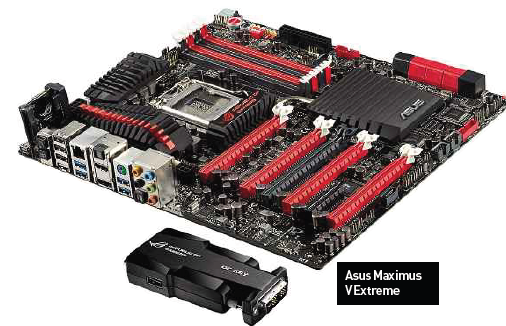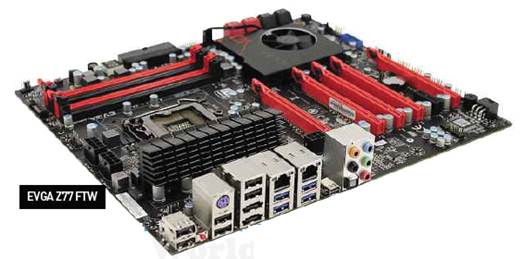Overclocking the Z77 FTW proved a little
more taxing. While its EFI groups settings well, it looks positively old-school
and feels more like an out-of date BIOS than the control system for a
super-high-end board. We disabled C-states and vdroop, set the multiplier to
48xand base block to 100MHz, and pushed the CPU voltage to 1300mV (1.32V), only
to find that our CPU frequently clocked down to 4.4GHz. The cause was the CPU
power management settings; setting the 'IA core current max and power limits'
to 2,040, 'long and short duration power limits’ to 255 and 'long duration
maintained power limit’ to 120 resolved the issue and resulted in a stable OC.

While both CPUs were running at similar
frequencies, the Extreme proved the faster board in our Media Benchmarks. An
overall score of 2,865 was close to 100 points clear of the Z77 FTW’s 2,770,
with the Extreme holding a 5 percent advantage in the video encoding test
alone. InCrysis2, both were inseparable, though, with each producing an
increased minimum frame rate of 32fps.
We also benchmarked both boards in a 3-way
SLI setup, courtesy of three GTX670 2GB cards connected to a 5,760 x 1,080
Nvidia Surround display. There was little to distance the two boards, though,
with both producing the same result in 63fps minimum in Battlefield 3,
demonstrating an impressive 91 per cent scaling for the three-card setup. We
found that the Z77 FTW was a little more power-hungry here, though, with our
system pulling a peak of 640W in BF3 compared to the Extreme’s 633W.
Conclusion
While both boards delivered the crazy frame
rates we expect from high-end multi-GPU setups, it’s tough to look beyond the
Asus Maximus V Extreme when choosing between the two. Despite its $60 premium
over the EVGAZ77 FTW, the Extreme offers many useful extra features, from WiFi
and Bluetooth to a Thunderbolt port and bundled 4-way SLI connector. It was
also consistently faster across our benchmarks - at least at 4.8GHz, which is
the limit of our test CPU.
Despite its victory, though, there’s no
award for the Maximus V Formula. Z77 boards are primarily limited by Intel’s
Ivy Bridge CPUs when overclocking, and the Extreme performs almost the same as
the $225 cheaper Asus Maximus V Gene in our benchmarks. Despite its epic
feature set, most people will struggle to find a use for many of the extras,
leaving 4-way SLI and CrossFireX as the only draw.
While we love the frame rates of multi-GPU
setups, dealing with their heat, noise and power consumption, not to mention
driver dependency, removes much of the shine, and you can still run a two-way
GPU setup on the Gene anyway. If you absolutely must have the biggest, most
capable Z77 motherboard around then the Maximus V Extreme is the one -
otherwise, you can get a decent board for half the money.
Results
Gimp image editing
·
Asus Maximus V: stock speed: 1,941; overclocked:
2,322
·
EVGA Z77 FTW: stock speed: 1,829; overclocked:
2,298
Handbrake H.264 video encoding
·
Asus Maximus V: stock speed: 3,463; overclocked: 4,312
·
EVGA Z77 FTW: stock speed:
3,289; overclocked: 4,098
Multi-tasking
·
Asus Maximus V: stock speed: 1,792; overclocked:
1,952
·
EVGA Z77 FTW: stock speed: 1,676; overclocked:
1,914
Overall
·
Asus Maximus V: stock speed: 2,399; overclocked:
2,865
·
EVGA Z77 FTW: stock speed: 2,265; overclocked:
2,770
Crysis 2
·
1,920 x1,080, High
settings, no AA, no AF 26fps I
32fps I 26fps
·
81fps
·
82fps
·
Asus Maximus V: stock speed min: 26fps, stock
speed avg: 81fps / overclocked min: 32fps, overclocked avg: 82fps
·
EVGA Z77 FTW: stock speed min: 26fps, stock
speed avg: 81fps / overclocked min: 32fps, overclocked avg: 82fps
Battlefield 3
·
5,760 x 1,080, 3 x GTX 670 2GB in 3-way SLI,
Ultra settings, 4x AA, 16x AF
·
Asus Maximus V: stock speed avg: 63fps /
overclocked avg: 74fps
·
EVGA Z77 FTW: stock speed avg: 63fps /
overclocked avg: 74fps
Scores: Asus
·
Speed: 42/45
·
Features: 30/30
·
Value: 10/25
·
Overall: 82%
Scores: EVGA
·
Speed: 38/45
·
Features: 25/30
·
Value: 11/25
·
Overall: 74%
ASUS Maximus V Extreme

ASUS
Maximus V Extreme
|
Pros and cons
Extreme: Faster; easy to overclock; great
EFI; lots of extras
Mundane: Pricey; little real-world speed
advantage over cheaper boards
How much?
Price: $468 inc VAT
Manufacturer: http://rog.asus.com
In detail
Chipset: Intel Z77
CPU support: LGA1155 Core i3, Core i5,
Core i7, Pentium and Celeron
Memory support: 4 slots: max 32GB DDR3 (up
to 3,200MHz)
Expansion slots: Five 16x PCI-E3.0 slot
(one at 16x or fiveat8x), one 1x PCI-E2 slot, one 1x mini-PCI-E2 slot
Sound: Realtek ALC898 7.1
Networking: Intel Gigabit Ethernet,
on-board Wi-Fi, on-board Bluetooth
Overclocking: Base clock80 - 300MHz, CPU
Multiplier 36- 63; max voltages, CPU 1.92V, RAM 1.92V, PLL2.5V
Ports: 3 x SATA 3Gbps (Z77), 1 x mSATA
3Gbps (Z77) 2 x SATA 6Gbps(Z77), 4 x SATA 6Gbps (ASMedia) 1 x PS/2, 8 x USB2
(Z77), 4 x USB3 (Z77), 4x USB 3 (ASMedia) LAN, 4 x surround audio out, line
in, mic, optical S/PDIF out, HDMI, Display Port, Thunderbolt
Dimensions (mm): 305 x 272 (EATX)
|
EVGA Z77 FTW

EVGA
Z77 FTW
|
Pros and cons
Winner: $60
cheaper than the Asus; dual- 1Gb/sec LAN
Runner-up: Slower
at stock and overclocked speeds; outdated EFI; harder to overclock; doesn't
include 4-way SLI bridge, WiFi, or Bluetooth
How much?
Price: $404 inc
VAT
In detail
Chipset: Intel
Z77
CPU support: LGA1155
Core i3, Core i5, Core i7, Pentium and Celeron
Memory support: 4
slots: max 32GB DDR3 (up to 3,000MHz)
Expansion slots: Five
16x PCI-E3 slot (One at 16x, four at 8x), one PCI-E2.16x slot, one PCI-E21x
slot
Sound: Realtek
ALC889 7.1
Networking: 2x
Marvell 88E8057
Overclocking: Base
clock 80 - 130MHz, CPU Multiplier 1680; max voltages, CPU 1.99V, RAM 1.99V,
PLL 2.6V
Ports: 4 x SATA
3Gbps (Z77), 2 x SATA 6Gbps (Z77), 2 x SATA 6Gbps (Marvell 9182) 2 x eSATA
(Marvell 88SE6121) 1 x PS/2, 10 x USB 2 (Z77), 4 x USB3 (Z77) 2 x USB 3
(ASMedia), 2 x LAN, 4 x surround audio out, line in, mic, optical S/PDIF out,
mini-DisplayPort
Dimensions (mm): 305
x 263.5 (EATX)
Test Kit
3.2GHz Intel Core i7-3770K CPU, 8GB
1,600MHz Corsair DDR3 memory, 128GB Patriot Wildfire SSD, Nvidia GeForce GTX
680 2GB graphics card, 3x GTX 670 2GB for3-way SLI, Windows 7 64-bit
|